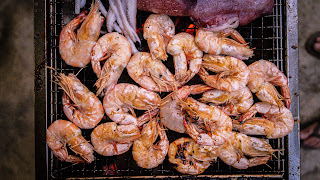What does the copper do in the body? The understanding nutrients series
Your monthly series is back, this time looking at the micronutrient copper. You can find the other nutrients I’ve covered here. Copper probably isn’t one of the first minerals you think of, but that doesn’t mean it’s not important.
Roles of copper:
Copper is a mineral that’s essential for our bodies to
function, it’s needed in small amounts but packs a punch. It plays many key
roles in the body.
Energy production: copper acts a cofactor for enzymes in the
production of energy. This means it helps the enzymes carry out their
biochemical reactions. Obviously, we need energy to live and so without copper,
we wouldn’t be able to produce ATP – what the body uses to power our
cells.
Iron absorption: another key role of copper is with iron
absorption. Iron is an essential mineral that’s needed by your red blood cells
to carry oxygen around the body. Copper helps the body absorb and utilise iron.
Both of these roles of copper also help with growth and
development as our bodies needs a lot of energy in order to continue growing.
Copper also plays a part in lung function, cardiovascular durability, the
immune system, and the creation of new blood vessels.
How much copper do we need?
Adult males and females need 1.2mg of copper a day.
About
half of what we consume is actually absorbed in our bodies. It’s absorbed in the small
intestine, with copper in meat tending to be better utilised than copper from
plant foods.
Sources of copper:
Copper is found in foods like shellfish, wholegrains, nuts
and seeds, potatoes, chocolate, and organ meats. This list isn’t exhaustive,
but is a selection of some of the sources of copper:
- 100g of boiled potatoes with the skin – 0.08mg
- 100g of cooked prawns – 0.28mg
- 25g of sunflower seeds – 0.56mg
- 100g of sweet potato – 0.18mg
- 100g of pig liver – 2.5mg
- 30g of plain milk chocolate – 0.1mg
- 100g of lentils – 0.22mg
- 25g of cashews – 0.52mg
- 2 slices of seeded bread – 0.47mg
What happens if you don’t get enough copper?
Copper deficiency is rare in humans, but it can occur if
your diet is really low in copper, or if you have genetic defects like Menkes
disease. A deficiency can lead to anaemia, weak connective tissue, bone
fragility, hypothermia, high cholesterol, and increased risk of infection.
It’s treated with supplementation and increasing copper in
your diet.
Copper toxicity is also rare, unless you have a genetic
disorder that affects copper metabolism. Copper toxicity can lead to permanent
liver damage or a haemolytic crisis where your body doesn’t make enough red
blood cells.
Key points:
- Copper has many roles in the body and is involved in: energy production, iron metabolism, the immune system, and growth and development.
- We need 1.2mg of copper a day.
- Sources of copper include wholegrains, nuts and seeds, shellfish, organ meats, and pulses.
- Copper deficiency is rare but can lead to anaemia, increased risk of infections, and weak bones.
I hope you enjoyed this blog post and learnt something new!
Bye for now 👋
References:
https://ods.od.nih.gov/factsheets/Copper-HealthProfessional/
.jpg)

.jpg)
.jpg)

Comments
Post a Comment